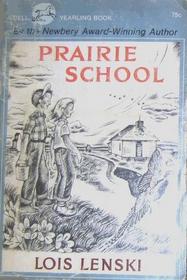Helpful Score: 6
This book reminded me strongly of Laura Ingalls Wilder's The Long Winter, set in South Dakota a hundred years later, in the winter of 1948-49. The students at the Prairie School are first and second generation children of German immigrants. They have no water, electricity, telephone, or plumbing at the schoolhouse, and some do not have these things in their homes, either. The book is based on actual events the children told the author the following spring when she visited their schoolhouse. I found several aspects of the story very interesting; the relationship of the children to their teacher (they fight over who gets to have overnights with her), the views the adults have toward electricity and central heat (mostly negative), the dynamics of the younger generation working the farm while their elderly parents live nearby in town (with modern amenities), and particularly the difficulties of growing up in a German community immediately after WWII. While suitable for even young children, I think adults will enjoy this book as a part of history and culture not often explored.
Helpful Score: 2
This book reminded me strongly of Laura Ingalls Wilder's The Long Winter, set in South Dakota a hundred years later, in the winter of 1948-49. The students at the Prairie School are first and second generation children of German immigrants. They have no water, electricity, telephone, or plumbing at the schoolhouse, and some do not have these things in their homes, either. The book is based on actual events the children told the author the following spring when she visited their schoolhouse. I found several aspects of the story very interesting; the relationship of the children to their teacher (they fight over who gets to have overnights with her), the views the adults have toward electricity and central heat (mostly negative), the dynamics of the younger generation working the farm while their elderly parents live nearby in town (with modern amenities), and particularly the difficulties of growing up in a German community immediately after WWII. While suitable for even young children, I think adults will enjoy this book as a part of history and culture not often explored.
Helpful Score: 2
This book reminded me strongly of Laura Ingalls Wilder's The Long Winter, set in South Dakota a hundred years later, in the winter of 1948-49. The students at the Prairie School are first and second generation children of German immigrants. They have no water, electricity, telephone, or plumbing at the schoolhouse, and some do not have these things in their homes, either. The book is based on actual events the children told the author the following spring when she visited their schoolhouse. I found several aspects of the story very interesting; the relationship of the children to their teacher (they fight over who gets to have overnights with her), the views the adults have toward electricity and central heat (mostly negative), the dynamics of the younger generation working the farm while their elderly parents live nearby in town (with modern amenities), and particularly the difficulties of growing up in a German community immediately after WWII. While suitable for even young children, I think adults will enjoy this book as a part of history and culture not often explored.
Helpful Score: 1
This book reminded me strongly of Laura Ingalls Wilder's The Long Winter, set in South Dakota a hundred years later, in the winter of 1948-49. The students at the Prairie School are first and second generation children of German immigrants. They have no water, electricity, telephone, or plumbing at the schoolhouse, and some do not have these things in their homes, either. The book is based on actual events the children told the author the following spring when she visited their schoolhouse. I found several aspects of the story very interesting; the relationship of the children to their teacher (they fight over who gets to have overnights with her), the views the adults have toward electricity and central heat (mostly negative), the dynamics of the younger generation working the farm while their elderly parents live nearby in town (with modern amenities), and particularly the difficulties of growing up in a German community immediately after WWII. While suitable for even young children, I think adults will enjoy this book as a part of history and culture not often explored.




